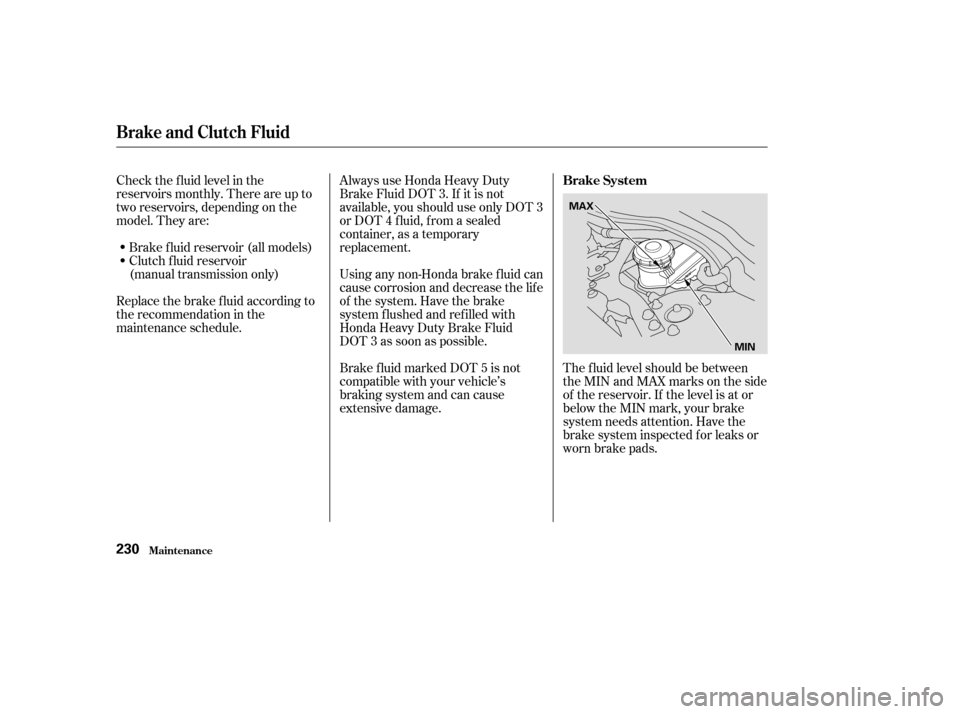Page 214 of 313
Fluid Locations
Maint enance
4-cylinder Models
215
BRAKE FLUID
(Gray cap)
ENGINE OIL DIPSTICK
(Orange handle)
WASHER FLUID
(Blue cap)
POWER STEERING
FLUID (Red cap)
RADIATOR CAPAUTOMATIC
TRANSMISSION
FLUID DIPSTICK
(Yellow loop)
ENGINE OIL
FILL CAP
CLUTCH FLUID
(5-speed Manual
Transmission only)
(Light gray cap)
ENGINE
COOLANT
RESERVOIR
�����—�����—�����y�
�������������y���
�(���%���
���y�����
���y
Page 215 of 313
Fluid Locations
Maint enance
6-cylinder Models
216
ENGINE OIL FILL CAPRADIATOR CAP
ENGINE OIL DIPSTICK
(Orange loop)
WASHER FLUID
(Blue cap)
POWER STEERING
FLUID (Red cap) BRAKE FLUID
(Gray cap)
AUTOMATIC
TRANSMISSION
FLUID DIPSTICK
(Yellow loop)
ENGINE
COOLANT
RESERVOIR
CLUTCH FLUID
(Gray cap)
(6-speed Manual
Transmission only)
�����—�����—�����y�
�������������y���
�(���%���
���y�����
���y
Page 229 of 313

Check the f luid level in the
reservoirs monthly. There are up to
two reservoirs, depending on the
model. They are:Brake f luid reservoir (all models)
Clutch f luid reservoir
(manual transmission only) Always use Honda Heavy Duty
Brake Fluid DOT 3. If it is not
available, you should use only DOT 3
or DOT 4 f luid, f rom a sealed
container, as a temporary
replacement.
Using any non-Honda brake f luid can
cause corrosion and decrease the lif e
of the system. Have the brake
system f lushed and ref illed with
Honda Heavy Duty Brake Fluid
DOT 3 as soon as possible.
The f luid level should be between
theMINandMAXmarksontheside
of the reservoir. If the level is at or
below the MIN mark, your brake
system needs attention. Have the
brake system inspected f or leaks or
worn brake pads.
Brake f luid marked DOT 5 is not
compatible with your vehicle’s
braking system and can cause
extensive damage.
Replace the brake f luid according to
the recommendation in the
maintenance schedule.
Brake and Clutch Fluid
Maint enance
Brake System
230
MAX
MIN
�����—�����—�����y�
�������������y���
�(���%���
���y���������y
Page 230 of 313
The f luid level should be between
theMINandMAXmarksontheside
of the reservoir. If it is not, add
brake f luid to bring it up to that level.
Use the same fluid specified for the
brake system.
Low f luid level can indicate a leak in
the clutch system. Have this system
inspected as soon as possible.Check the level on the side of the
reservoir when the engine is cold.
The f luid should be between the
UPPER LEVEL and LOWER LEVEL.
If not, add power steering f luid to the
UPPER LEVEL mark.
CONT INUED
Brake and Clutch Fluid, Power Steering Fluid
Maint enance
Power Steering Fluid
Clutch System
231
6-cylider models UPPER LEVEL
LOWER LEVEL
4-cylider models LOWER LEVEL UPPER LEVEL
MAX
MIN
�����—�����—�����y�
�������������y���
�(���%���
���y���������y
Page 238 of 313
Open the trunk and remove the
socket f rom the light assembly by
turning it one-quarter turn counter-
clockwise.
Remove the burned-out bulb by
pulling it straight out of the socket.
Install the new bulb into the
socket.Reinstall the socket. Turn it
clockwise until it locks.
Turn on the lights to make sure
the new bulb is working.
1. 2. 3. 4.
Lights
Maint enance
Replacing a High-mount Brake
Light Bulb
239
BULB
SOCKET
�����—�����—�����y�
�������������y���
�(���%���
���y���������y
Page 250 of 313

Thesechainsaretheonlyonesthat
have been approved by Honda f or
use on your vehicle. Since Honda
cannot test all chains, you must be
personally responsible f or proper
selection, installation, and use of
snow chains.The chains listed here are available
at many auto supply stores. For a
complete list of stores, visit the SCC
website at www.scc-chain.com.
When installing chains, f ollow the
manuf acturer’s instructions, and
mount them as tightly as you can.
Drive slowly with chains installed.
If you ever hear the chains
contacting the body or chassis, stop
and investigate. If the chains have
loosened, retighten them. Make sure
they do not contact the brake lines
or suspension.
Removethechainsassoonasyou
begin driving on cleared roads.
CH2412T
Cable-types: SCC Radial Chain
CH2311T or SCC SC Cable SC1030
Link-type: SCC Quick Grip QG1134
Cable-types: SCC Radial Chain
CH2311T or SCC SC Cable SC1030
EX, LX-V6 and EX-V6 with automatic
transmission
EX-V6 with manual transmission
LX
Tires
Maint enance251
NOTICE:
Using the wrong chains, or not
properly installing chains, can
damage the brake lines and
cause a crash in which you can
be seriously injured or killed.
Follow all instructions in this
owner’s manual regarding the
selection and use of tire chains. Traction devices that are the
wrong size or improperly installed can
damage your vehicle’s brake lines,
suspension, body, and wheels. Stop
driving if they are hitting any part of
the vehicle.
�����—�����—�����y�
���������
���y���
�(���%���
���y���������y
Page 253 of 313

If you need to park your vehicle f or
an extended period (more than one
month), there are several things you
should do to prepare it f or storage.
Proper preparation helps prevent
deterioration and makes it easier to
get your vehicle back on the road. If
possible, store your vehicle indoors.Fill the f uel tank.
Change the engine oil and f ilter.
Wash and dry the exterior
completely.
Cleantheinterior.Makesurethe
carpeting, floor mats, etc. are
completely dry.
Leave the parking brake off. Put
the transmission in Reverse
(manual) or Park (automatic).
Block the rear wheels. If the vehicle is to be stored f or a
longer period, it should be
supported on jackstands so the
tires are of f the ground.
Leave one window open slightly (if
the vehicle is being stored
indoors).
Disconnect the battery.
Support the f ront wiper blade
arms with a f olded towel or rag so
they do not touch the windshield.
To minimize sticking, apply a
silicone spray lubricant to all door
and trunk seals. Also, apply a
vehiclebodywaxtothepainted
surfaces that mate with the door
and trunk seals.
Cover the vehicle with a
‘‘breathable’’ cover, one made
f rom a porous material such as
cotton. Non-porous materials, suchas plastic sheeting, trap moisture,
which can damage the paint.
If possible, periodically run the
engine until it reaches f ull
operating temperature (the
cooling f ans cycle on and of f
twice). Pref erably, do this once a
month.
If you store your vehicle f or 1 year or
longer, have your Honda dealer
perf orm the inspections as soon as
youtakeitoutof storage(seepages and ). The 6-cylinder model
needs the inspections called f or in
the 2 years/30,000 miles (48,000 km)
maintenance schedule (Normal
Conditions) and the 4-cylinder model
needs the inspections called f or in
the 2 years/40,000 miles (64,000 km)
maintenance schedule (Normal
Conditions). The replacements
called f or in the maintenance
schedule are not needed unless the
vehicle has actually reached that
time or mileage. 205 210
Vehicle Storage
Maint enance254
�����—�����—�����y�
�������������y���
�(���%���
���y���������y
Page 254 of 313

This section covers the more
common problems that motorists
experience with their vehicles. It
gives you inf ormation about how to
safely evaluate the problem and what
to do to correct it. If the problem has
stranded you on the side of the road,
you may be able to get going again.
If not, you will also f ind instructions
on getting your vehicle towed.......................
Compact Spare Tire . 256
....................
Changing a Flat Tire . 257
.............
If the Engine Won’t Start . 262
................................
Jump Starting . 264
..............
If the Engine Overheats . 266
.........
Low Oil Pressure Indicator . 268
..........
Charging System Indicator . 269
.......
Malf unction Indicator Lamp . 269
...............
Brake System Indicator . 271
......................
Emergency Towing . 272
..................
Closing the Moonroof . 274
..............................................
Fuses . 275
..............................
Fuse Locations . 278
Taking Care of the Unexpected
T aking Care of t he Unexpect ed255
�����—�����—�����y�
�������������y���
�(���%���
���y���������y